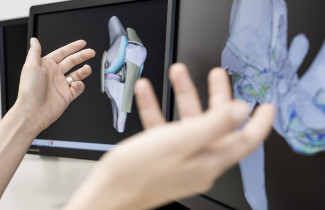Knee joint injuries are typically related to sports, such as football, rugby, or ice hockey. However, it is not known whether and how those injuries lead to severe post-traumatic osteoarthritis. Ultimately, in advanced stage osteoarthritis, joint cartilage breaks down which causes severe joint pain and lack of mobility. Even though tissue overloading has been suggested to contribute to this disease, exact mechanisms leading to osteoarthritis remain unclear. Thus, the future joint condition and possible development of osteoarthritis cannot be currently predicted, and the examining doctor cannot know whether the disease develops to a person or not.
In this thesis, sophisticated numerical knee joint models were created for evaluating biomechanical responses of the knee joint tissues, especially articular cartilage and ligaments, during walking. A model with a cartilage degeneration algorithm was also developed and validated based on experimental measurements. Different degenerative mechanisms, such as excessive cartilage deformation and fluid velocity, were evaluated to simulate the deterioration of cartilage tissue. Finally, this validated degenerative algorithm was implemented into 3D patient-specific numerical knee joint models to simulate cartilage damage progression after an ACL injury and reconstruction during walking.
The findings in this thesis revealed that compression-tension relationship in knee ligaments due to the fibril-reinforcement contributes substantially to the knee joint function and cartilage loading. The models with the degeneration algorithm indicated that excessive fluid velocity, as well as maximum shear and deviatoric strain mechanisms, lead to changes in cartilage composition around articular cartilage defects similar to the degradation observed in the experiments. Furthermore, mechanobiological knee joint models were able to predict subject-specific cartilage degeneration in similar locations to those revealed by MRI follow-up maps after ACL reconstruction.
These promising results might open a possibility for this model to be employed to predict subject-specific progression of post-traumatic osteoarthritis and to evaluate the effect of clinical interventions. Specifically, this model could identify high and low-risk lesions in cartilage for osteoarthritis development and suggest an optimal and personalized rehabilitation protocol.
The study has received funding from the European Union’s Horizon 2020 research and innovation programme under the Marie Sklodowska-Curie grant No 713645.
The doctoral dissertation of MSc Gustavo Orozco Grajales, entitled Mechanobiological modeling of articular cartilage: predicting post-traumatic knee osteoarthritis will be examined at the Faculty of Science and Forestry on the 22nd of May. The opponent in the public examination will be Professor Yasin Y. Dhaher, Northwestern University, USA, and the custos will be Professor Rami Korhonen, University of Eastern Finland. The public examination will be held in English.


